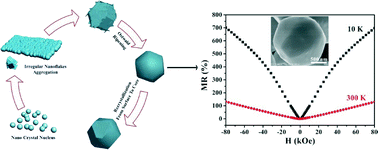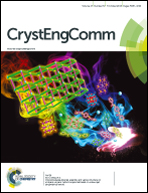Controlled synthesis of truncated octahedral bismuth micron particles with giant positive magnetoresistance†
Abstract
Large magnetoresistance (MR) effects in bismuth depend on crystallinity and grain size. In this paper, we report for the first time Bi micron particles (BMPs) with large MR that can be produced on a large scale and with high quality through a simple low-temperature solvothermal reduction route in a highly alkaline media system. Almost all the BMPs have the very interesting structural characteristic of a rounded truncated octahedral shape. In addition, the reaction and growth mechanism of the truncated octahedral BMPs is proposed on the basis of experimental data. It starts with an alkaline media-homogeneous nucleation, and then small crystal nuclei aggregate into irregular nanoflakes and assemble into polycrystalline microspheres at the lead of the CTAC soft template with the nucleus growing at the same time. Then surface recrystallizations happen to form the truncated octahedral bismuth micron particles via Ostwald ripening. With prolonged time, recrystallization continues from the surface to the core anisotropically. Moreover, the MR of the truncated octahedral BMPs can reach up to 130% at room temperature (T = 300 K) and 700% at temperature T = 10 K in an 8 T field, respectively, with nonhysteretic and quasi-linear field dependence.


 Please wait while we load your content...
Please wait while we load your content...